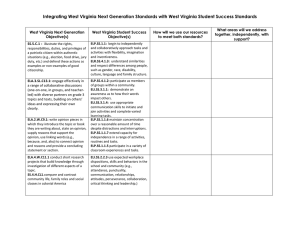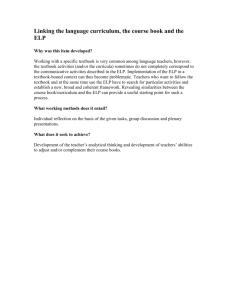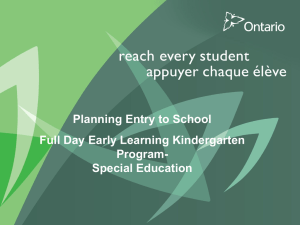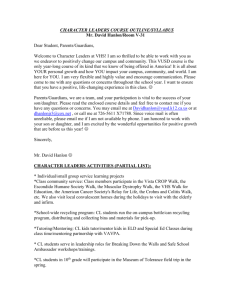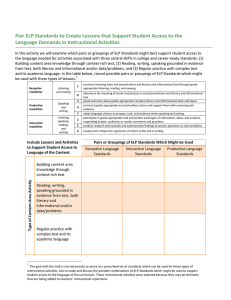UNPACKING THE NEW ENGLISH LANGUAGE PROFICIENCY STANDARDS
advertisement
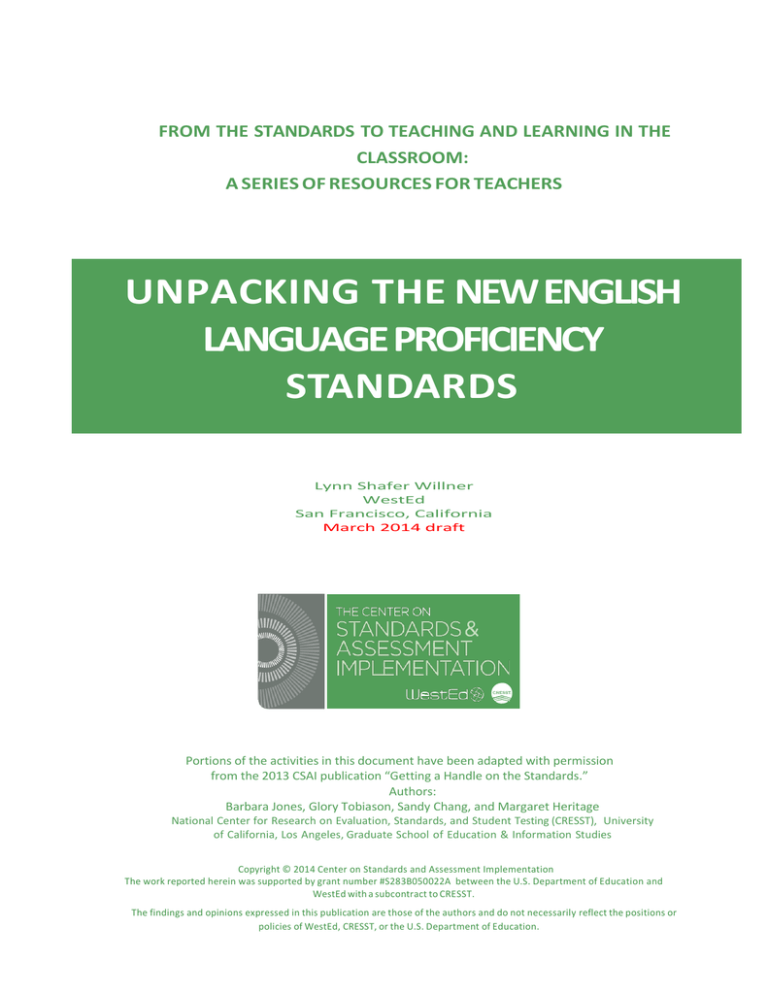
FROM THE STANDARDS TO TEACHING AND LEARNING IN THE CLASSROOM: A SERIES OF RESOURCES FOR TEACHERS UNPACKING THE NEW ENGLISH LANGUAGE PROFICIENCY STANDARDS Lynn Shafer Willner WestEd San Francisco, California March 2014 draft Portions of the activities in this document have been adapted with permission from the 2013 CSAI publication “Getting a Handle on the Standards.” Authors: Barbara Jones, Glory Tobiason, Sandy Chang, and Margaret Heritage National Center for Research on Evaluation, Standards, and Student Testing (CRESST), University of California, Los Angeles, Graduate School of Education & Information Studies Copyright © 2014 Center on Standards and Assessment Implementation The work reported herein was supported by grant number #S283B050022A between the U.S. Department of Education and WestEd with a subcontract to CRESST. The findings and opinions expressed in this publication are those of the authors and do not necessarily reflect the positions or policies of WestEd, CRESST, or the U.S. Department of Education. Unpacking the New ELP Standards Overview This resource is part of a series produced by the Center for Standards and Assessment Implementation to assist teachers and those who support teachers to plan teaching and learning using the new English Language Proficiency (ELP) Standards. In 2013, the Council of Chief State School Officers (CCSSO) utilized the services of WestEd and the Understanding Language Initiative at Stanford University to develop these new ELP Standards. An important first step in preparing to teach the new ELP Standards well is to understand the content of the ELP Standards and how they differ from States’ prior ELP Standards. This resource provides an introduction to the ELP Standards and outlines a detailed process that teachers can use to become knowledgeable about the standards and prepare to teach them. How to use this resource This resource provides an overview of the ELP Standards as well as activities for educators to examine the ELP Standards in depth. It uses a three-step process to unpack the new ELP Standards. Step One: Upon which conceptual frameworks and guiding principles are the new ELP Standards based? Step Two: What does each new ELP Standard entail? Step Three: What processes and resources should be in place to implement the new ELP Standards? Step One Activities: Browse the new ELP Standards documents Describe the antithesis of each Guiding Principle for the new ELP Standards Step Two Activities: Interpret the new ELP Standards Examine commonalities among the new ELP Standards Examine distinctions among certain new ELP Standards Classify the Depth of Knowledge associated with the language demands of certain new ELP Standards Explore the language demands of ELA, Mathematics, and Science Tasks Analyze the new ELP Standards by domain and compare current and new ELP Standards Examine the vertical progressions of the new ELP Standards Compare current and new ELP Standards Step Three Activities: Determine the degree to which specific ELP Standards are currently being instructed Determine how lessons might be integrated into units Determine next steps and resources needed for ELP Standards implementation The information and materials provided in this resource are intended to help educators at all levels better understand the new ELP Standards. Educators can choose to work through all sections of this resource individually or as a group (recommended) or to use and/or adapt specific sections to tailor this resource to their needs. In addition to the text placed in this document, please refer to the resources posted in https://wested.box.com/ELPStandardsResources. What does each new ELP Standard entail? 2 Unpacking the New ELP Standards Browse the new ELP Standards 1. Browse the ELP Standards, noticing particular points of interest, including: Introduction (which is the 1st layer within each ELP Standards document) ELP Standards (which is the 2nd layer within each ELP Standards document) ELP Standards with correspondences (which is the 3rd layer within each ELP Standards document) Glossary Specific grade level or course of greatest interest Share your observations with a partner or small group. (Note: Partners might prefer to read, discuss, and record observations together. Reading and recording observations individually first is designed to provide individuals with the think-time prior to discussions, which may not be the preference of the partners.) 2. Record your observations. Reminder on how to quickly navigate the individual ELP Standards documents Each individual ELP Standards document (for a single set of either K, 1, 2-3, 4-5, 6-8, or 9-12 standards) contains a single set of grade/grade span ELP Standards and supporting tools which are arranged in 3 layers, with more detail added in each successive layer. Sample Document Maps: Show General and Detailed View of the ELP Standards: To move quickly through the electronic versions of the documents, use the hyperlinks either (a) in the Table of Contents on pages 1–2 on the individual ELP Standards documents or (b) in the bookmarks to the left of each ELP Standards document page. The bookmark feature [in PDFs] and the navigation pane or Document Map [in Word documents] can be activated using the document tool bar. 3 Unpacking the New ELP Standards Browse the new ELP Standards Tour the new ELP Standards. What are your observations? Organize your observations using the following categories. Facts, Details Reactions, Feelings Questions New Ideas, Connections What is most important here? Frame group discussion of this organizer as a K-W-L: (a) This is what we know about the ELP Standards; (b) this is what we want to learn; and (c) later, return and discuss: This is what we found out. 4 Unpacking the New ELP Standards Describe the Antithesis of the Guiding Principles for the new ELP Standards Directions: Read the Guiding Principles around which the ELP Standards have been designed. With a partner or by groups, develop a list of what each guiding principle does not state, its antithesis.) Guiding Principles 1 1. Potential ELLs have the same potential as native speakers of English to engage in cognitively complex tasks. Regardless of ELP level, all 1 ELLs need access to challenging, grade-appropriate curriculum, instruction, and assessment and benefit from activities requiring them to create linguistic output (Ellis, 2008a; 2008b). Even though ELLs will produce language that includes features that distinguish them from their native-English-speaking peers, “it is possible [for ELLs] to achieve the standards for collegeand-career readiness” (NGA Center & CCSSO, 2010b, p. 1). 2. Funds of Knowledge ELLs’ primary languages and other social, cultural, and linguistic background knowledge and resources (i.e., their “funds of knowledge” [Moll, Amanti, Neff, & González, 1992]) are useful tools to help them navigate back and forth among their schools and their communities’ valuable resources as they develop the social, cultural, and linguistic competencies required for effective communication in English. In particular, an awareness of culture should be embedded within curriculum, instruction, and assessment provided to ELLs since “the more one knows about the other language and culture, the greater the chances of creating the appropriate cultural interpretation of a written or spoken text” (National Standards in Foreign Language Education Project, 2006, p. 37). 3. Diversity in ELL Progress in Acquiring English Language Proficiency A student’s ability to demonstrate proficiency at a particular ELP level will depend on context, content-area focus, and developmental factors. Thus, a student’s designated ELP level represents a typical current performance level, not a fixed status. An English language proficiency level does not identify a student (e.g., “Level 1 student”), but rather identifies what a student knows and can do at a particular stage of English language development, for example, “a student at Level 1” or “a student whose listening performance is at Level 1.” Progress in acquiring English may vary depending upon program type, age at which entered program, initial English proficiency level, native language literacy, and other factors (Bailey & Heritage, 2010; Byrnes & Canale, 1987; Lowe & Stansfield, 1988). Within these ELP Standards, we assume parallel development of language and content-area knowledge, skills, and abilities. ELLs do not need to wait until their ELP is sufficiently developed to participate in content area instruction and assessment. “Research has shown that ELLs can develop literacy in English even as their oral proficiency in English develops (Bunch, Kibler, & Pimentel, 2013, p. 15). Antithesis of Each Guiding Principle Grade appropriate is defined by the English language arts, mathematics, and science standards for that grade. 5 Unpacking the New ELP Standards Scaffolding ELLs at all levels of ELP should be provided with scaffolding in order to reach the next reasonable proficiency level as they develop grade-appropriate language capacities, particularly those that involve content-specific vocabulary and registers. The type and intensity of the scaffolding provided will depend on each student’s ability to undertake the particular task independently while continuing to uphold appropriate complexity for the student. 4. Students with Limited or Interrupted Formal Education ELLs with limited or interrupted formal education must be provided access to targeted supports that allow them to develop foundational literacy skills in an accelerated time frame (DeCapua & Marshall, 2011). Educators can refer to the Common Core State Standards (CCSS) for ELA section “Reading: Foundational Skills” (NGA Center & CCSSO, 2010) for this purpose. 5. Special Needs ELLs with disabilities can benefit from English language development services (and are required to have language development goals as part of their Individualized Education Plans [IEPs]). Educators should be aware that these students may take slightly different paths toward English language proficiency. 6. Access Supports and Accommodations Based on their individual needs, all ELLs, including ELLs with disabilities, should be provided access supports and accommodations for assessments, so that their assessment results are valid and reflect what they know and can do. Educators should be aware that these access supports and accommodations can be used in classroom instruction and assessment to ensure that students have access to instruction and assessment based on the ELP Standards. When identifying the access supports and accommodations that should be considered for ELLs and ELLs with IEPs or 504 plans during classroom instruction and assessment, it is particularly useful to consider ELL needs in relation to receptive and productive modalities. 7. Multimedia, Technology, and New Literacies New understandings around literacy (e.g., visual and digital literacies) have emerged around use of information and communication technologies (International Reading Association, 2009). Relevant, strategic, and appropriate multimedia tools and technology, aligned to the ELP Standards, should be integrated into the design of curriculum, instruction, and assessment for ELLs. 6 Unpacking the New ELP Standards Interpret the New ELP Standards Each of the 10 standard statements outlines a goal for the English language proficiency which ELLs will need to develop to participate independently in grade-appropriate classroom activities. Use a pencil to write the gist of each statement in your own words. Analyze the new ELP Standards to identify which ones address listening, speaking, reading, and writing. Place a check mark next to the domains from the list in the column to the right. Try to reach consensus on the domains addressed in each. Take turns sharing your interpretations of the standards with the whole group. Provide feedback to one another and make changes to your summary as needed, until you are confident you understand the main points of your standard, including how it is distinct from the other ELP Standards. We will revisit these summaries as we complete the next few activities. # ELP Standard Statements Domains Addressed? 1 construct meaning from oral presentations and literary and informational text through grade-appropriate listening, reading, and viewing Listening Speaking Reading Writing Listening Speaking Reading Writing 2 participate in grade-appropriate oral and written exchanges of information, ideas, and analyses, responding to peer, audience, or reader comments and questions 3 speak and write about grade-appropriate complex literary and informational texts and topics Listening Speaking Reading Writing 4 construct grade-appropriate oral and written claims and support them with reasoning and evidence Listening Speaking Reading Writing 5 conduct research and evaluate and communicate findings to answer questions or solve problems 6 analyze and critique the arguments of others orally and in writing 7 adapt language choices to purpose, task, and audience when speaking and writing Listening Speaking Reading Writing Listening Speaking Reading Writing Listening Speaking Reading Writing 8 determine the meaning of words and phrases in oral presentations and literary and informational text 9 create clear and coherent grade-appropriate speech and text 10 make accurate use of standard English to communicate in grade-appropriate speech and writing Listening Speaking Reading Writing Listening Speaking Reading Writing Listening Speaking Reading Writing 7 Unpacking the New ELP Standards Examine Commonalities among the New ELP Standards With a partner (or in a triad), examine your ELP Standard summaries from the previous activity and brainstorm which ELP Standards have elements in common or a common focus. In the circular bubble, create a label for the group of standards recorded in the rectangular boxes on the right side of the page. [You do not need to complete each rectangular text box.] What kinds of groupings did you and your colleagues identify? What conclusions or generalizations can you make? The goal with this task is not necessarily to arrive at definitive classifications of the standards but to study and discuss them in terms of the different teaching and learning they require. Follow-up: Are there any ways in which your ELP Standard summaries on p. 7 can be adjusted? Commonality ELP Standards 8 Unpacking the New ELP Standards Examine distinctions among certain ELP Standards Directions: Examine the ELP Standards shown below. How are they different from each other? What types of different teaching and learning do they require? Follow-up: Are there any ways in which your ELP Standard summaries on p. 7 can be adjusted? Standard 1: construct meaning from oral presentations and literary and informational text through grade-appropriate listening, reading, and viewing Standard 8: determine the meaning of words and phrases in oral presentations and literary and informational text Similarities Differences Differences Standard 2: participate in gradeappropriate oral and written exchanges of information, ideas, and analyses, responding to peer, audience, or reader comments and questions Standard 7: adapt language choices to purpose, task, and audience when speaking and writing Similarities Differences Differences 9 Unpacking the New ELP Standards Classify the Depth of Knowledge associated with the Language Demands of Certain ELP Standards Directions: Examine the ELP Standards below. What is the depth of knowledge (DOK) associated with the language demands described in each standard? Place the number for each standard next to the appropriate DOK section(s) in the chart. Be prepared to explain your thinking. What generalizations or conclusions can you now make? Follow-up: Are there any ways in which your ELP Standard summaries on p. 7 can be adjusted? Standard 3: speak and write about grade-appropriate complex literary and informational texts and topics Standard 4: construct grade-appropriate oral and written claims and support them with reasoning and evidence Standard 5: conduct research and evaluate and communicate findings to answer questions or solve problems Standard 6: analyze and critique the arguments of others orally and in writing 10 Unpacking the New ELP Standards Explore the Language Demands of ELA, Mathematics, and Science Tasks To ensure the ELP standards specify the language that all ELLs must acquire in order to successfully engage with collegeand-career-ready standards in ELA & Literacy, mathematics, and science, the new ELP Standards employ two methods of correspondence mappings: Example of New ELP Standards with Correspondences Each ELP Standard contains a standard statement and 5 ELP levels First Set of Correspondences: Each ELP Standard contains correspondences with Standards for Practice: English Practices (EPs), Mathematical Practices (MPs), and Science Practices (SPs) Second Set of Correspondences: Each ELP Standard contains correspondences with CCSS for ELA content standards CCSS for ELA & Literacy The K–5 standards focus on reading, writing, speaking, listening, and language across the curriculum, reflecting the fact that most or all of the instruction students in these grades receive comes from one teacher The grades 6–12 standards are covered in two content area–specific sections, the first for English language arts teachers and the second for teachers of history/social studies, science, and technical subjects. What are the practices? The term practices refers to behaviors which developing student practitioners should increasingly use when engaging with the content and growing in content-area maturity and expertise throughout their elementary, middle, and high school years. The CCSS Standards for Mathematical Practices a.k.a., the Mathematical Practices are the first eight standards for the CCSS for Mathematics The NGSS Science and Engineering Practices are one of three dimensions in every NGSS standard. A set of ELA “Practices” was created for the CCSSO ELPD Framework since the CCSS for ELA & Literacy did not include specific practices in their original form. The ELP Standards address the types of language proficiency that ELLs need as they engage in content-area practices (and, therefore, may show slightly different groupings of practices with each ELP Standard than the groupings shown in Figure 1). “By explicitly calling attention to these practices, state ELP Standards [can be designed to] cultivate higher order thinking skills in ELLs and target their ability to comprehend and communicate about complex text” (CCSSO, 2012, p. 16). 11 Unpacking the New ELP Standards Summarize the Language Demands among the Content Area Practices Create a summary for the converging practices shown in each of the section in the diagram below. Summaries for the Diagram Sections I. EP2, EP5, MP3, EP4, SP7: II. SP2, MP4, SP5: III. SP8, EP2: IV. EP7, MP5: V. MP1, MP2, MP6, MP7, MP8: VI. SP1, SP3, SP4, SP6: VII. EP4, EP5, EP6: 12 Unpacking the New ELP Standards K-12 Practices Matrix Use the K-12 Practices Matrix to identify a practice and its corresponding ELP Standard. In the ELP Standards documents, you can click on the ELP Standard number to go to the standard. The purpose of the K-12 Practices Matrix [and also the ELA Standards Matrix for each Grade Level] is to help teachers design lesson plans which leverage the strongest correspondences between the ELP Standards and the CCSS and NGSS. However, depending on the instructional activity, and as educators’ familiarity with the standards is built, educators may identify other correspondences that also make sense. The matrices are intended to help educators start with correspondence analyses—they are not an endpoint. The matrices do not contain a fixed set of correspondences. Practices ELA “Practices”2 (EP) 1 2 3 EP1 EP1 EP1 ELP Standards 4 5 6 7 8 9 10 EP2 EP2 EP1. Support analyses of a range of grade-level complex texts with evidence. EP1 EP1 EP2. Produce clear and coherent writing in which the EP3. EP4. EP5. EP6. development, organization, and style are appropriate to task, purpose, and audience. Construct valid arguments from evidence and critique the reasoning of others. Build and present knowledge through research by integrating, comparing, and synthesizing ideas from texts. Build upon the ideas of others and articulate his or her own when working collaboratively. Use English structures to communicate contextspecific messages. Mathematical Practices (MP) EP2 EP3 EP2 EP2 EP3 EP3 EP4 EP5 EP5 1 2 3 MP1 MP1 MP1 EP4 EP4 EP5 EP5 EP5 EP6 EP6 4 5 6 MP1 MP1 EP2 EP6 EP6 EP6 7 8 9 MP1 MP1 10 MP1. Make sense of problems and persevere in solving them. MP2. Reason abstractly and quantitatively. MP3. Construct viable arguments and critique the MP4. MP5. MP6. MP7. MP8. Science Practices (SP) SP1. SP2. SP3. SP4. SP5. SP6. SP7. SP8. MP3 reasoning of others. Model with mathematics. Use appropriate tools strategically. Attend to precision. Look for and make use of structure. Look for and express regularity in repeated reasoning. Ask questions and define problems. Develop and use models. Plan and carry out investigations. Analyze and interpret data. Use mathematics and computational thinking. Construct explanations and design solutions. Engage in argument from evidence. Obtain, evaluate, and communicate information. 1 MP6 MP6 MP6 2 3 4 MP3 MP3 MP6 5 SP1 MP6 6 7 8 SP1 SP1 SP1 SP6 SP7 SP8 SP6 9 10 SP7 SP8 SP8 SP3 SP4 SP6 SP8 SP4 SP6 SP8 SP6 SP7 SP8 SP8 SP8 SP8 2 While the CCSS for mathematics and the NGSS explicitly state key practices and core ideas for their respective discipline, the corresponding features in the ELA charts were identified through a close analysis of the priorities contained within the standards themselves (because the CCSS for ELA do not explicitly identify key practices and core ideas) (CCSSO, 2012, p. 16). 13 Unpacking the New ELP Standards Examine the vertical progressions of the new ELP Standards Reviewing how the ELP Standards are organized across grade levels (e.g., from K-12) can help teachers gain a broader sense of the progression of learning that occurs as students become more sophisticated in their understanding of a particular concept or skill described in a standard or a related set of standards. Instructions for Vertical Progression Analysis 1. Access one of the vertical progression Excel spreadsheet found in “SEA Study Group Materials” folder in https://wested.box.com/ELPStandardsResources 2. Examine the standards for one grade level/span, as well as the related standards a few grade levels/spans above and a few below your own. Notice how the English language proficiency knowledge and skills develop progressively. 3. If you do this work with a partner or as part of a larger group (e.g., teachers in grade-level bands), you can jigsaw the work, with each pair studying a few standards and their progression and then sharing what they learn with others. 4. Use the handout below to summarize the nature of the progression. 14 Unpacking the New ELP Standards Examine the vertical progression of the new ELP Standards Originally adapted from Marcelletti & Saunders (2012, p. 18). Reproduced with permission. Name(s)_______________________________________________________Grade/Grade Span: Directions: Using the ELP Standards progressions spreadsheet examine how each standard progresses from grade/grade span to the next grade/grade span. ELP Standards 1 2 How does this standard progress across grade level/spans? [Summarize] construct meaning from oral presentations and literary and informational text through gradeappropriate listening, reading, and viewing participate in grade-appropriate oral and written exchanges of information, ideas, and analyses, responding to peer, audience, or reader comments and questions 3 speak and write about gradeappropriate complex literary and informational texts and topics 4 construct grade-appropriate oral and written claims and support them with reasoning and evidence 5 conduct research and evaluate and communicate findings to answer questions or solve problems 6 analyze and critique the arguments of others orally and in writing 7 adapt language choices to purpose, task, and audience when speaking and writing 8 determine the meaning of words and phrases in oral presentations and literary and informational text 9 create clear and coherent gradeappropriate speech and text 10 make accurate use of standard English to communicate in grade-appropriate speech and writing 15 Unpacking the New ELP Standards Compare current and new ELP Standards The goal with this task is not necessarily to arrive at definitive classifications of the standards by category but to study and discuss them in terms of the different teaching and learning they require. 1. Use the State’s current ELP Standards as the starting point. Pick a grade and a domain (listening, speaking, reading, and writing) to review first. 2. Identify the domain in your State’s current standards that corresponds with the new ELP standards. 3. Place both sets of standards documents with the grade level strand you will be reviewing side-byside so you can look at them simultaneously. It may be helpful to have a partner or small group to work with. 4. Code and annotate each of the current and new standards in the strand you’re reviewing to represent one of the four categories described below, using a different code for each category. The categories are: Same, Similar but More Rigorous, New, and Removed. It may be helpful to use highlighters to color code the documents. 5. Once you have finished coding the current and new standards, take some time to reflect on general trends that you noticed in each of the strands and the standards as a whole. Use the worksheet below to write down your reflections. Coding Categories • Same: The new standard is the same or nearly identical to a current standard (choose one color to highlight all the standards that have a correlate in the new/current standards). Also, write the strand initials and number of the related standard from the new/current version of standards in parentheses after the text. • Similar but More Rigorous: The new standard is similar to a current standard, but the new standard is more rigorous. Color code all the new/current standards that have this type of relationship in the same color. Add the strand initials and number from the matching standard(s) in the parentheses after the corresponding standard’s text while also adding the word “Rigor” after the number. You can also underline the section of the new standard that is more rigorous than the current one. • New: The new standard has no corresponding standard in the current standards. These new standards can be color coded separately from the others with the phrase “ELP 2013” in parentheses after the standard’s text. This indicates a new area for instructional focus. • Removed: A current standard has no corresponding standard in the new standards. These current standards can be color coded separately from the others and the phrase “Removed” included in parentheses after the standard’s text. 16 Unpacking the New ELP Standards Analyze the ELP Standards by Domain and Compare Current and New ELP Standards Originally adapted from Marcelletti & Saunders (2012, p. 18). Reproduced with permission. Name(s)__________________________________________________Grade/Grade Span: _______________ Directions: Review and compare the current and new ELP standards. What is the same? What is similar but more rigorous? What is new to the ELP standards at this grade/grade span? [The domains have already been identified.] Domains How does this compare to our Coding? ELP Standards current ELP Standards? 1 2 3 4 construct meaning from oral presentations and literary and informational text through grade-appropriate listening, reading, and viewing participate in gradeappropriate oral and written exchanges of information, ideas, and analyses, responding to peer, audience, or reader comments and questions speak and write about gradeappropriate complex literary and informational texts and topics construct grade-appropriate oral and written claims and support them with reasoning and evidence Reading Listening Listening Speaking Reading Speaking Writing Speaking Writing conduct research and evaluate and communicate findings to answer questions or solve problems Listening Speaking Reading Writing 6 analyze and critique the arguments of others orally and in writing Listening Speaking Reading Writing 7 adapt language choices to purpose, task, and audience when speaking and writing determine the meaning of words and phrases in oral presentations and literary and informational text 9 create clear and coherent grade-appropriate speech and text 10 make accurate use of standard English to communicate in gradeappropriate speech and writing Same Same but more rigorous New Removed Writing 5 8 Same Same but more rigorous New Removed Speaking Writing Same Same but more rigorous New Removed Same Same but more rigorous New Removed Same Same but more rigorous New Removed Same Same but more rigorous New Removed Same Same but more rigorous New Removed Same Same but more rigorous New Removed Same Same but more rigorous New Removed Same Same but more rigorous New Removed Unpacking the New ELP Standards Implementation Considerations After examining the new ELP Standards in depth, an important next step in thinking about the ELP Standards is to determine what existing resources are currently available for providing instruction in each of the standards. Follow the step-by-step directions below to complete the next three activities. Instructions for Implementation Coding 1. To begin the process, review (on your own or with a partner) each of your grade/grade span ELP Standards in turn and ask yourself: (1) Is this something I already teach and have all the materials for? (2) Is it something I partially teach and need to develop further lessons for my units around and collect supporting materials? (3) Is this brand new, and do I have to begin thinking about how to instruct students in the concept or skill for the first time? 2. As you review each standard, code it with one of the following four categories: Currently Covered, Needs Refinement, Needs Development, and Not Sure. Use the four acronyms described in the text box below for this purpose. 3. After you have finished coding, begin thinking about ways that you can adapt your current curriculum to provide instruction in each of the standards. This may include determining where you need to carve out more time to teach more rigorous concepts. How might lessons involving the new ELP Standards be integrated into units and instructional modules? 4. Compile a list of additional resources you need to implement the new standards, including types of texts, lessons and units that need to be revised or planned, new materials, structural changes you want to make to your classroom practices, time to discuss implementation with your professional learning community, and any additional coaching or administrative support. Explanation of Implementation Codes Codes cc Currently Covered This standard is being effectively addressed through our existing program and teaching. nr Needs Refinement This standard will require refinement of our existing program and teaching in order to address it effectively. nd Needs Development This standard will require development of materials and/or teaching methods in order to address it effectively. ?? Not Sure Just not sure which code to use for this standard, and/or what this new standard actually means. 18 Unpacking the New ELP Standards Determine the degree to which specific ELP Standards are currently being instructed Orginally adapted from Marcelletti & Saunders (2012, p. 115). Reproduced with permission. Name(s)_______________________________________________________Grade/Grade Span:____________ Directions: Assign a code to each standard and provide notes that explain why you assigned that particular code to the standard. See the previous page for explanations of codes. ELP Implementation Standard Code Notes 1 2 3 4 5 6 7 8 9 10 cc = currently covered nr = needs refinement nd = needs development ?? = not sure 19 Unpacking the New ELP Standards Determine how lessons might be integrated by concepts and themes into units It is important to remember that both the college and career-ready standards and the new ELP Standards are intended to go into greater depth using units and projects (rather than surface coverage through decontextualized lessons). Are there activities around common concepts or themes that this standard can enhance or support? Name(s)_______________________________________________________Grade/Grade Span: Directions: Choose a group of standards to work with and then list the number of the standard, the curriculum materials you have available to provide instruction in that standard, and the implementation code you gave the standard in the previously activity. Consider how this standard might be integrated into the new instructional units and modules being introduced in your school or district. ELP Standard Existing Curriculum Material Implementation Code How might this ELP Standard be integrated into existing units or modules? 1 2 3 4 5 6 7 8 9 nr = needs refinement nd = needs develo 10 cc = currently covered nr = needs refinement nd = needs development ?? = not sure Unpacking the New ELP Standards c = currently covered nr = needs refinement nd = needs development ?? = not sure Determine next steps and resources needed for ELP Standards implementation. Adapted from CRESST, UCLA, 2013 Name(s)_______________________________________________________Grade/Grade Span:__________________ Directions: Choose a group of standards to work with and then list the number of the standard, the curriculum materials you have available to provide instruction in that standard, the implementation code you gave the standard in the two previous activities, and what materials or other resources you still need to be able to teach the standard. ELP Standard Existing Curriculum Material Implementation Code Next Steps/What We Need 1 2 3 4 5 6 7 8 9 nr = needs refinement nd = needs develo 10 cc = currently covered nr = needs refinement nd = needs development ?? = not sure 21
